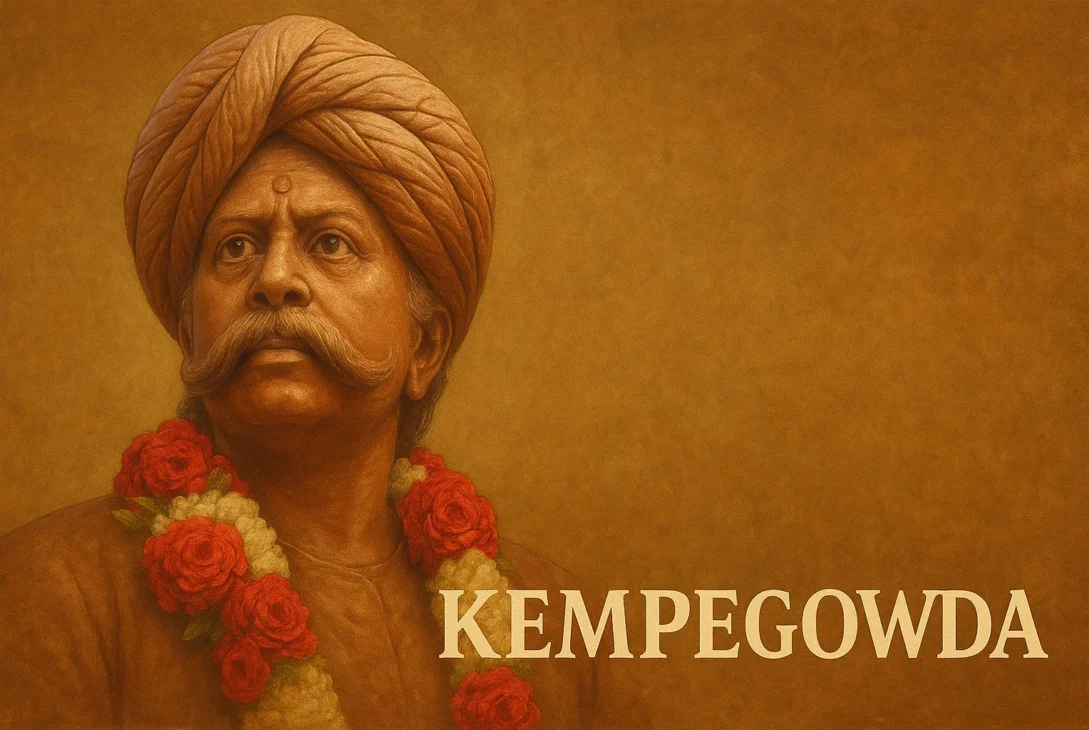Introduction
Nadaprabhu Kempegowda, the founder of Bangalore, is a historical figure whose legacy extends far beyond the foundation of a city. Known for his visionary leadership, bravery, and deep sense of empathy for his people, Kempegowda’s story is a beacon of inspiration. Born into the Yelahanka dynasty, he ascended to greatness and left behind a city that would grow into one of India’s most significant urban centers. This article delves into his life, his contributions to Bangalore’s establishment, and his leadership qualities that shaped the region’s future.
Early Life and Education
Kempegowda was born to Kempanjegowda, the sixth ruler of the Yelahanka kingdom, and Lingamambe, who hailed from Koduge near Bangalore. From an early age, Kempegowda exhibited qualities of bravery, leadership, and wisdom. At six, he was enrolled in Shivagange Gurukula, where he studied religion, literature, poetry, philosophy, and martial arts. Despite being a prince, Kempegowda led a humble life, and his education helped shape his views on equality, leadership, and service to the people.
Kempegowda’s childhood was marked by his sense of adventure and daring feats, such as climbing the dangerous Shivaganga hills. His bravery and quick thinking were evident when, as a young boy, he defended the Gurukula by punishing thieves who had stolen cows, showcasing his innate sense of justice and protection.
Family Background and Early Leadership
Kempegowda’s father, Kempanjegowda, a powerful ruler of the Yalahanka kingdom, was well-versed in both administration and warfare. Under his leadership, the kingdom flourished. As the eldest son, Kempegowda was groomed for leadership from a young age. His leadership journey began when he was eighteen, and he quickly became involved in the political and administrative matters of his kingdom.
His marriage to Chennamambe, a young woman of noble descent, was a key milestone in his life. She was a strong and cultured woman, and their union played a significant role in the consolidation of Kempegowda’s position in Yalahanka.
The Visionary Founder of Bangalore
Kempegowda is best known for founding the city of Bangalore in 1537. His vision for the city was clear: he sought to create a prosperous capital for his kingdom, inspired by the grandeur of Vijayanagara. While some historians suggest that Bangalore existed before Kempegowda’s time, he is widely recognized as the founder of modern-day Bangalore.
Kempegowda transformed Bangalore into a well-planned city with strong fortifications. He recognized the importance of strategic planning and infrastructure, laying the foundation for the city’s future growth. His reign saw significant developments, including the establishment of a fortified city, which would later become the heart of the Bangalore we know today.
Leadership and Administrative Qualities
Kempegowda’s leadership was marked by a unique blend of empathy, practicality, and vision. He often interacted with the common people, understanding their struggles and addressing their needs. This connection to his subjects earned him their loyalty and respect.
He was not only an administrator but also an empathetic leader who focused on the welfare of his people. His approach to governance was holistic, considering both the material and spiritual needs of his subjects. He engaged with people from all walks of life, gaining insights into their lives and struggles. This grounded approach to leadership made him highly respected among his peers and subjects.
Kempegowda’s administrative acumen was also influenced by his exposure to the Vijayanagara Empire. He admired the prosperity and order in the Vijayanagara kingdom, and he sought to implement similar practices in his own rule. His attention to the economic and social development of his kingdom helped Yalahanka thrive during his reign.
The Necklace of Diamonds Strategy
Kempegowda’s strategic thinking is sometimes linked to the concept of the “Necklace of Diamonds” strategy, which is said to symbolize a network of interlinked urban areas that form a prosperous region. While historical records regarding this specific strategy are sparse, the analogy of a network of connected cities reflects Kempegowda’s vision for Bangalore. His planning of the city’s infrastructure and his efforts to build a strong, prosperous region were in line with this strategy, which focused on creating connections between various key locations to bolster the overall prosperity of the kingdom.
Conclusion: Kempegowda’s Lasting Legacy
Nadaprabhu Kempegowda’s legacy extends beyond the establishment of Bangalore. His leadership, vision, and commitment to his people shaped the course of history in the region. Today, Bangalore stands as a testament to his foresight and dedication. As the founder of the city, Kempegowda remains a role model for leadership, inspiring generations with his values of equality, empathy, and service to the people.
Through his efforts, Kempegowda transformed not just a city, but an entire culture, leaving an indelible mark on Karnataka’s history. His story is one of bravery, wisdom, and a deep commitment to his people, making him a true visionary and a beloved figure in Indian history.















